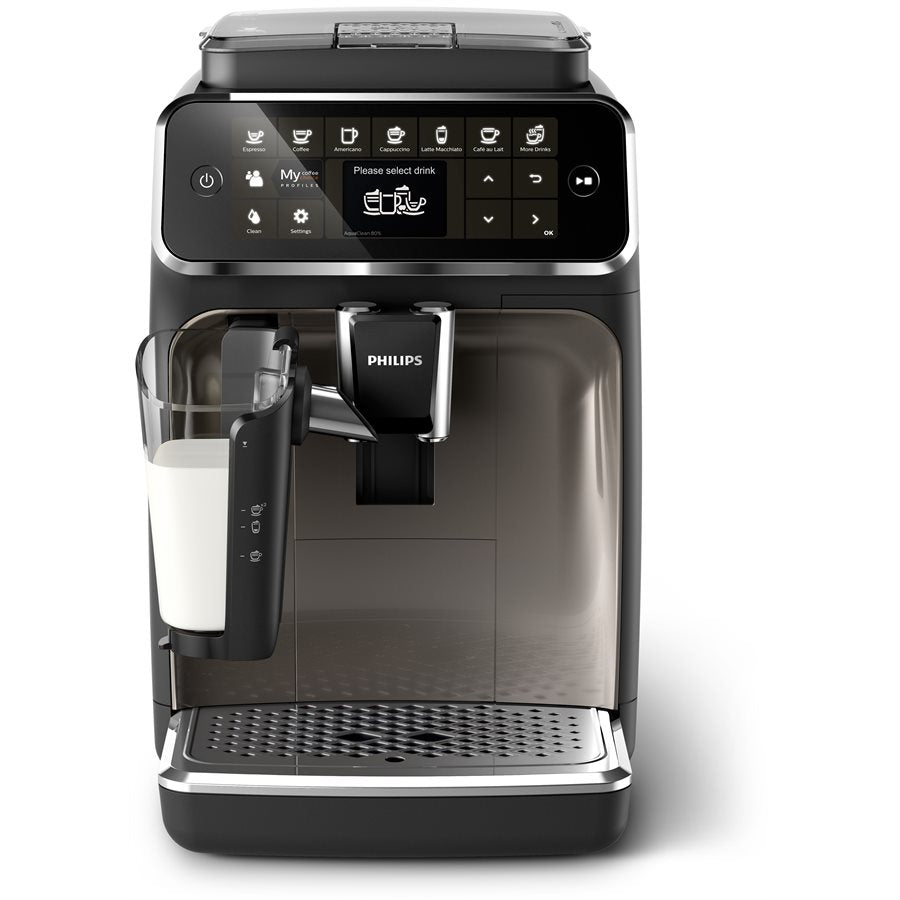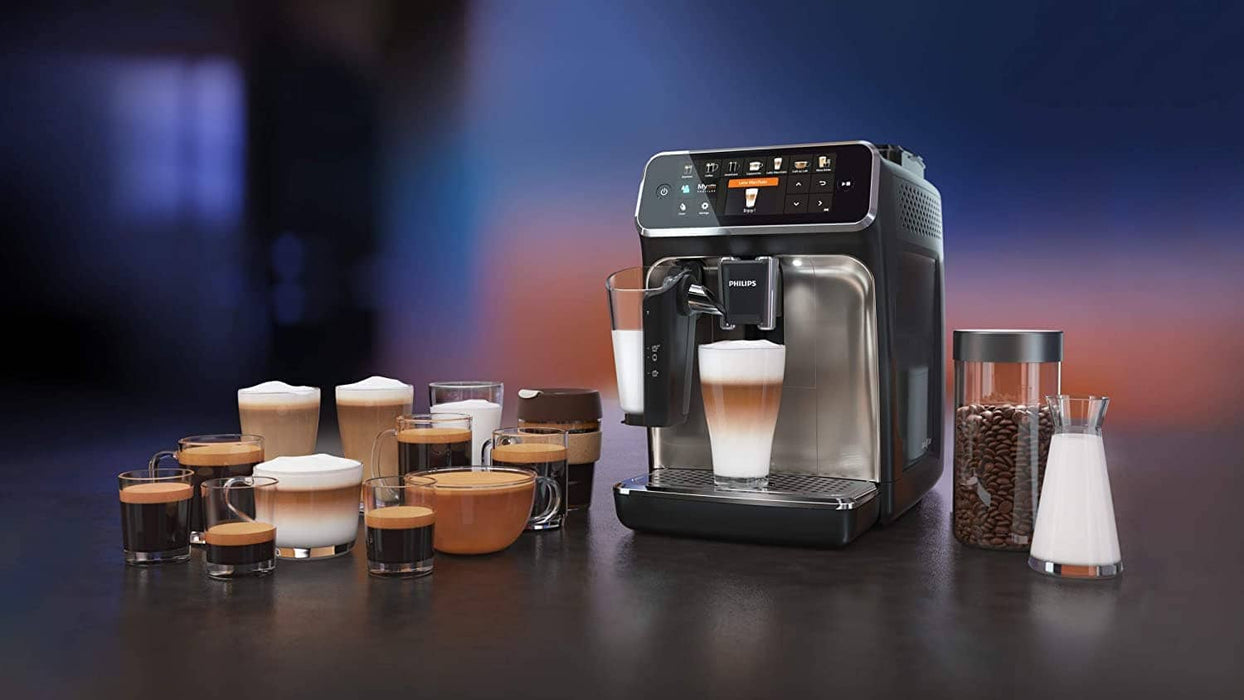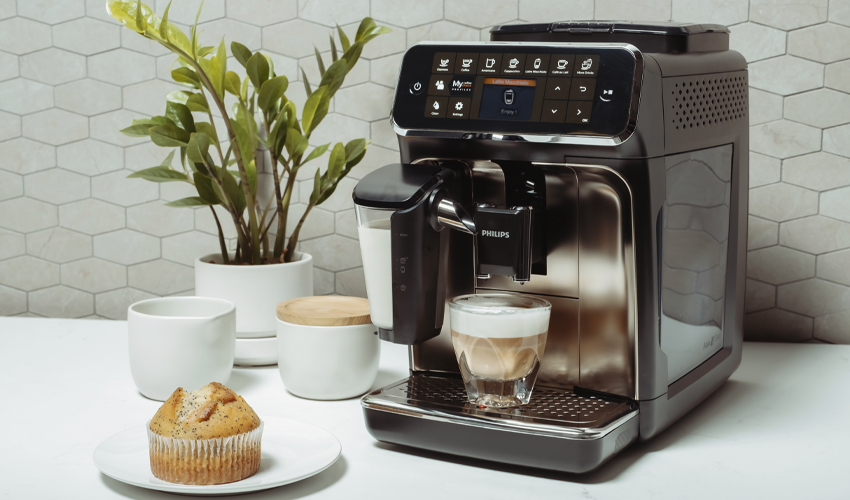#1: Philips LatteGo 5400

- Wide variety of drinks
- Advanced customization
- User profile options
#2: Philips LatteGo 4300

- Basic milk frother
- Small water tank
- Noisy grinder
If you’re anything like me, you understand the importance of a good cup of coffee. It’s not just about waking up or getting through the day—it's about enjoying that perfect moment with a warm, freshly brewed drink that hits all the right notes. After trying several coffee machines over the years, I finally narrowed my search down to the Philips LatteGo series, specifically the 5400 and the 4300. Both models have their strengths, but after some time of using each, I found myself gravitating towards the Philips LatteGo 5400. Here’s why I believe it has the edge over the 4300.
User Experience: Philips LatteGo 5400 vs 4300
When it comes to user experience, both the Philips LatteGo 5400 and 4300 are designed with convenience in mind. The touch display on the 5400 is a bit more advanced, and it allowed me to quickly select my preferred coffee type without having to scroll through a long list. I found that after a few weeks of using the machine, I could prepare my favorite drinks almost automatically.
The Philips 4300 vs LatteGo 5400 coffee machine comparison is also simple to use, but its interface is a little more basic. It still gets the job done, but for me, the streamlined experience on the 5400 made it easier to experiment with different drinks and settings.

Customization Options: Philips LatteGo 5400 vs 4300
Both machines allow you to tweak the strength and volume of your coffee, but the Philips LatteGo 5400 takes things a step further with its ability to adjust the temperature, coffee strength, and milk foam density. This customization was crucial for me, as I prefer my coffee to be on the stronger side but with a smooth, creamy foam.
On the 4300, the options are more limited. While you can still adjust the coffee strength and volume, I missed having more control over the temperature and milk texture. For casual coffee drinkers, this might not be an issue, but if you're like me and enjoy customizing your coffee to your exact preferences, the 5400 offers a more versatile experience.
Milk System and Cleaning: Philips LatteGo 5400 vs 4300
The LatteGo milk system is a standout feature on both machines, and for good reason. It's incredibly easy to use and clean. There’s no annoying tubing to deal with, and everything can be cleaned in the dishwasher, which is a huge plus for anyone with a busy schedule.
In my experience, the milk frothing on the 5400 was just a bit better. The foam was consistently thicker and creamier, which made a difference in my lattes and cappuccinos. The 4300 still does an excellent job frothing milk, but the 5400's milk foam felt slightly more refined. This is a small detail, but one that adds to the overall coffee experience if you’re someone who pays attention to these nuances.
Versatility in Drink Customization: Philips LatteGo 5400 vs 4300
As someone who enjoys different types of coffee drinks, I found that the Philips 5400 vs 4300 comparison gave me more room to customize and create my perfect cup. It’s not just about choosing between an espresso or a cappuccino—the 5400 lets you adjust the milk and coffee quantities in ways that the 4300 doesn’t.
For example, on lazy weekend mornings when I wanted a lighter, milk-heavy drink, I could adjust the settings to give me just the right balance. On busier days, when I needed a quick, strong hit of espresso, the machine delivered that too—precisely how I liked it. This kind of flexibility is something that I’ve come to appreciate more the longer I use the 5400.

Customization Features: Philips LatteGo 5400 vs 4300
Customization is key to crafting the perfect cup of coffee, and the Philips 4300 vs 5400 lattego review reveals the 5400’s superior ability to personalize drinks. With more options to adjust drink strength, temperature, and volume, the 5400 offers more control over your coffee-making process. The Philips 5400 vs 4300 espresso machine review shows that while the 4300 offers basic customizations, the 5400’s broader range of options is more suitable for those who enjoy experimenting.
Milk Frothing: A Key Difference
Both machines feature the LatteGo milk system, but the Philips 4300 vs LatteGo 5400 coffee machine comparison emphasizes that the 5400 consistently produces creamier, more velvety froth. If you prioritize milk-based drinks like lattes and cappuccinos, the 5400’s superior frothing system will elevate your coffee experience.
User Experience and Interface
In terms of user experience, the Philips LatteGo 5400 vs 4300 comparison shows that the 5400’s larger touchscreen and streamlined interface make it easier to navigate and brew your favorite drinks with just a few taps. While the Philips 4300 vs LatteGo 5400 model is also user-friendly, its smaller display and fewer options make the experience feel more limited.
Cleaning and Maintenance: Philips LatteGo 5400 vs 4300
Let’s be honest—no one enjoys cleaning coffee machines. But with both the Philips LatteGo 5400 and 4300, the process is surprisingly hassle-free. The LatteGo system is incredibly easy to disassemble and clean, and since there are no milk tubes, the cleaning process takes just a few minutes. In my experience, this has made a big difference, especially when I’m in a rush and don’t have the time to deal with more complex cleaning tasks.
The removable brewing group on both machines can be rinsed under running water, which I found to be quick and efficient. However, the 5400 provides a bit more feedback on when cleaning is needed, which helped me stay on top of maintenance without having to check everything manually.
Value for Money: Philips LatteGo 5400 vs 4300
In terms of value, the Philips LatteGo 4300 is certainly more affordable than the 5400. For someone who just wants a reliable coffee machine that delivers great drinks without too many extra features, the 4300 is a solid choice. It covers all the basics and does so with quality and ease.
That said, I found that the Philips 5400 vs 4300 espresso machine review offers more value in the long run. Yes, it’s a bit more expensive upfront, but the added coffee options, customization features, and premium design make it a worthwhile investment for someone who takes their coffee seriously. For me, the 5400 wasn’t just a machine—it became an essential part of my morning routine, offering a consistently enjoyable experience.

Conclusion
After spending time with both machines, I can confidently say that the Philips LatteGo 5400 vs 4300 review is the better option if you’re looking for a more versatile, customizable, and premium coffee experience. The 4300 is a great machine, especially if you're more budget-conscious, but the 5400 offers that extra level of refinement that makes a noticeable difference in everyday use.
Ultimately, both machines deliver excellent coffee, but if you're willing to spend a little more for added customization and an expanded coffee menu, the Philips 5400 vs 4300 comparison is well worth it. It’s a machine that caters not just to your caffeine needs but also to your personal coffee preferences, making it a fantastic addition to any kitchen.
Frequently Asked Questions (FAQ)
Q: What is the main difference between the Philips LatteGo 5400 and 4300?
A: The primary difference lies in the variety of coffee drinks offered and customization options. The Philips LatteGo 5400 offers 12 drink specialties, compared to the 4300's 8. Additionally, the 5400 has more advanced customization features, allowing you to fine-tune the strength, temperature, and milk froth density more precisely than the 4300.
Q: Is the Philips LatteGo 5400 worth the higher price compared to the 4300?
A: If you enjoy a wide variety of coffee drinks and prefer more control over customization (such as adjusting milk foam and temperature), the 5400 offers a more premium experience. However, if you are satisfied with fewer drink options and basic customization, the 4300 still provides excellent value at a lower price point.
Q: How easy is it to clean the Philips LatteGo system?
A: Both the 5400 and 4300 models feature the same easy-to-clean LatteGo system. There are no milk tubes, making it quick and straightforward. The milk container can be disassembled and washed in the dishwasher or rinsed under running water.
Q: Do both machines have the same milk frothing system?
A: Yes, both the Philips LatteGo 5400 and 4300 feature the same innovative LatteGo milk system. However, the 5400 provides slightly more consistent and denser froth, which makes a noticeable difference in the texture of milk-based drinks.
Q: Can I program my favorite drinks on both machines?
A: Yes, both models allow you to program and save your favorite drinks for quick access. The Philips LatteGo 5400's interface makes this process a bit more seamless with its larger touch display, which allows for easier customization and quick selections.
Q: Are the Philips LatteGo 5400 and 4300 good for families?
A: Absolutely. Both machines are user-friendly and versatile, making them great for families where each person may have different coffee preferences. The 5400 is particularly suited to households that enjoy a wider variety of coffee drinks, while the 4300 is ideal for families who enjoy the basics.
Q: How large are the water and bean containers in both machines?
A: The Philips LatteGo 5400 has a slightly larger water tank and bean hopper than the 4300, meaning fewer refills. This is particularly convenient if you plan on making multiple cups throughout the day.
Q: Do I need to use specific types of coffee beans or milk with these machines?
A: No, both the 5400 and 4300 are compatible with any coffee beans and standard milk types. You can also use plant-based milk alternatives like almond or oat milk, although the foam consistency may vary slightly compared to dairy milk.
Q: Which model is better for someone new to espresso machines?
A: The Philips LatteGo 4300 might be a better choice for someone new to espresso machines due to its simplicity and affordability. However, if you're interested in exploring more coffee varieties and customization options, the Philips LatteGo 5400 is still easy to use and offers more advanced features.
Q: How long do both machines take to brew a cup of coffee?
A: Both machines have a fast brewing process, with the Philips LatteGo 5400 being slightly quicker in start-up and brewing time. You'll typically have a cup of coffee ready within a minute or two from turning on the machine.
